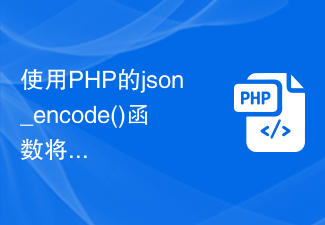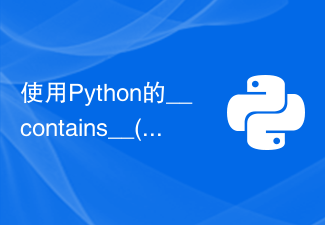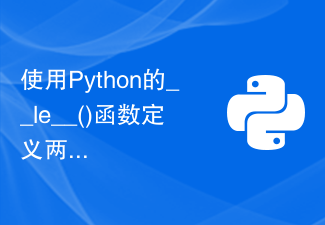
Object Oriented (OO) is a software development method. Object-oriented concepts and applications have transcended programming and software development and expanded to fields such as database systems, interactive interfaces, application structures, application platforms, distributed systems, network management structures, CAD technology, artificial intelligence and other fields. Object-oriented is a method of understanding and abstracting the real world. It is the product of the development of computer programming technology to a certain stage
Recommended tutorial:java development tutorial
Concept
⑴Object.
Objects are anything that people want to study. From the simplest integers to complex airplanes, they can be regarded as objects. They can not only represent specific things, but also abstract rules, plan or event.
⑵The state and behavior of the object.
Objects have state, and an object uses data values to describe its state.
Objects also have operations, which are used to change the state of the object. The object and its operations are the behavior of the object.
The object realizes the combination of data and operations, so that the data and operations are encapsulated in the unity of the object
⑶ class.
The abstraction of objects with the same characteristics (data elements) and behavior (functions) is a class. Therefore, the abstraction of an object is a class, and the concretization of a class is an object. It can also be said that an instance of a class is an object, and a class is actually a data type.
Classes have attributes, which are abstractions of the state of objects. Data structures are used to describe the attributes of the class.
A class has an operation, which is an abstraction of the object's behavior, described by the operation name and the method to implement the operation.
⑷Class structure.
There are several categories in the objective world, and there are certain structural relationships between these categories. There are usually two main structural relationships, namely general-specific structural relationships and whole-part structural relationships.
①General--the specific structure is called a classification structure, which can also be said to be an "or" relationship or an "is a" relationship.
②The whole-part structure is called the assembly structure, and the relationship between them is an "and" relationship, or a "has a" relationship.
⑸Messages and methods.
The structure used to communicate between objects is called a message. In object operations, when a message is sent to an object, the message contains information for the receiving object to perform a certain operation. Sending a message must at least include the name of the object receiving the message and the name of the message sent to the object (i.e. object name, method name). Generally, the parameters must be explained. The parameters can be variable names known to the object that knows the message, or global variable names known to all objects.
The implementation process of operations in a class is called a method. A method has a method name, return value, parameters, and method body.
Features
⑴Object uniqueness.
Each object has its own unique identifier, through which the corresponding object can be found. During the entire lifetime of an object, its identity does not change, and different objects cannot have the same identity.
⑵Abstractness.
Abstraction refers to abstracting objects with consistent data structures (properties) and behaviors (operations) into classes. A class is an abstraction that reflects important properties related to an application while ignoring other irrelevant content. The division of any class is subjective, but must be related to the specific application.
⑶Inheritance.
Inheritance is a mechanism for subclasses to automatically share the data structures and methods of parent classes. This is a relationship between classes. When defining and implementing a class, you can do it on the basis of an existing class, take the content defined by the existing class as your own content, and add some new content.
Inheritance is the most important feature that distinguishes object-oriented programming languages from other languages and is not found in other languages.
In the class hierarchy, a subclass inherits only the data structure and methods of a parent class, which is called single inheritance.
In the class hierarchy, when a subclass inherits the data structures and methods of multiple parent classes, it is called multiple inheritance.
Multiple inheritance, JAVA, VB, NET, and Objective-C only support single inheritance. Note that when using multiple inheritance in C, you need to be careful about ambiguity.
In software development, the inheritance of classes makes the software created open and extensible. This is an effective method of organizing and classifying information. It simplifies the creation of objects and classes. volume, increasing code reusability.
Use inheritance to provide a standardized hierarchical structure of classes. Through the inheritance relationship of classes, public features can be shared, improving the reusability of software
⑷Polymorphism (polymorphism)
Polymorphism means that the same operation, function, or process can be applied to multiple types of objects and obtain different results. Different objects can produce different results when receiving the same message. This phenomenon is called polymorphism.
Polymorphism allows each object to respond to a common message in a way that suits it.
Polymorphism enhances software flexibility and reusability.
The above is the detailed content of What is object-oriented programming. For more information, please follow other related articles on the PHP Chinese website!
 使用PHP的json_encode()函数将数组或对象转换为JSON字符串Nov 03, 2023 pm 03:30 PM
使用PHP的json_encode()函数将数组或对象转换为JSON字符串Nov 03, 2023 pm 03:30 PMJSON(JavaScriptObjectNotation)是一种轻量级的数据交换格式,已经成为Web应用程序之间数据交换的常用格式。PHP的json_encode()函数可以将数组或对象转换为JSON字符串。本文将介绍如何使用PHP的json_encode()函数,包括语法、参数、返回值以及具体的示例。语法json_encode()函数的语法如下:st
 源码探秘:Python 中对象是如何被调用的?May 11, 2023 am 11:46 AM
源码探秘:Python 中对象是如何被调用的?May 11, 2023 am 11:46 AM楔子我们知道对象被创建,主要有两种方式,一种是通过Python/CAPI,另一种是通过调用类型对象。对于内置类型的实例对象而言,这两种方式都是支持的,比如列表,我们即可以通过[]创建,也可以通过list(),前者是Python/CAPI,后者是调用类型对象。但对于自定义类的实例对象而言,我们只能通过调用类型对象的方式来创建。而一个对象如果可以被调用,那么这个对象就是callable,否则就不是callable。而决定一个对象是不是callable,就取决于其对应的类型对象中是否定义了某个方法。如
 使用Python的__contains__()函数定义对象的包含操作Aug 22, 2023 pm 04:23 PM
使用Python的__contains__()函数定义对象的包含操作Aug 22, 2023 pm 04:23 PM使用Python的__contains__()函数定义对象的包含操作Python是一种简洁而强大的编程语言,提供了许多强大的功能来处理各种类型的数据。其中之一是通过定义__contains__()函数来实现对象的包含操作。本文将介绍如何使用__contains__()函数来定义对象的包含操作,并且给出一些示例代码。__contains__()函数是Pytho
 使用Python的__le__()函数定义两个对象的小于等于比较Aug 21, 2023 pm 09:29 PM
使用Python的__le__()函数定义两个对象的小于等于比较Aug 21, 2023 pm 09:29 PM标题:使用Python的__le__()函数定义两个对象的小于等于比较在Python中,我们可以通过使用特殊方法来定义对象之间的比较操作。其中之一就是__le__()函数,它用于定义小于等于比较。__le__()函数是Python中的一个魔法方法,并且是一种用于实现“小于等于”操作的特殊函数。当我们使用小于等于运算符(<=)比较两个对象时,Python
 详解Javascript对象的5种循环遍历方法Aug 04, 2022 pm 05:28 PM
详解Javascript对象的5种循环遍历方法Aug 04, 2022 pm 05:28 PMJavascript对象如何循环遍历?下面本篇文章给大家详细介绍5种JS对象遍历方法,并浅显对比一下这5种方法,希望对大家有所帮助!
 Python中如何使用getattr()函数获取对象的属性值Aug 22, 2023 pm 03:00 PM
Python中如何使用getattr()函数获取对象的属性值Aug 22, 2023 pm 03:00 PMPython中如何使用getattr()函数获取对象的属性值在Python编程中,我们经常会遇到需要获取对象属性值的情况。Python提供了一个内置函数getattr()来帮助我们实现这个目标。getattr()函数允许我们通过传递对象和属性名称作为参数来获取该对象的属性值。本文将详细介绍getattr()函数的用法,并提供实际的代码示例,以便更好地理解。g
 使用Python的isinstance()函数判断对象是否属于某个类Aug 22, 2023 am 11:52 AM
使用Python的isinstance()函数判断对象是否属于某个类Aug 22, 2023 am 11:52 AM使用Python的isinstance()函数判断对象是否属于某个类在Python中,我们经常需要判断一个对象是否属于某个特定的类。为了方便地进行类别判断,Python提供了一个内置函数isinstance()。本文将介绍isinstance()函数的用法,并提供代码示例。isinstance()函数可以判断一个对象是否属于指定的类或类的派生类。它的语法如下
 PHP代码封装技巧:如何使用类和对象封装可重复使用的代码块Jul 29, 2023 pm 11:19 PM
PHP代码封装技巧:如何使用类和对象封装可重复使用的代码块Jul 29, 2023 pm 11:19 PMPHP代码封装技巧:如何使用类和对象封装可重复使用的代码块摘要:在开发中,经常遇到需要重复使用的代码块。为了提高代码的可维护性和可重用性,我们可以使用类和对象的封装技巧来对这些代码块进行封装。本文将介绍如何使用类和对象封装可重复使用的代码块,并提供几个具体的代码示例。使用类和对象的封装优势使用类和对象的封装有以下几个优势:1.1提高代码的可维护性通过将重复

Hot AI Tools

Undresser.AI Undress
AI-powered app for creating realistic nude photos

AI Clothes Remover
Online AI tool for removing clothes from photos.

Undress AI Tool
Undress images for free

Clothoff.io
AI clothes remover

AI Hentai Generator
Generate AI Hentai for free.

Hot Article

Hot Tools

SAP NetWeaver Server Adapter for Eclipse
Integrate Eclipse with SAP NetWeaver application server.

Dreamweaver Mac version
Visual web development tools

SecLists
SecLists is the ultimate security tester's companion. It is a collection of various types of lists that are frequently used during security assessments, all in one place. SecLists helps make security testing more efficient and productive by conveniently providing all the lists a security tester might need. List types include usernames, passwords, URLs, fuzzing payloads, sensitive data patterns, web shells, and more. The tester can simply pull this repository onto a new test machine and he will have access to every type of list he needs.

SublimeText3 Linux new version
SublimeText3 Linux latest version

EditPlus Chinese cracked version
Small size, syntax highlighting, does not support code prompt function





